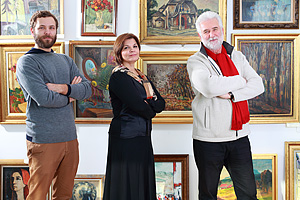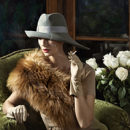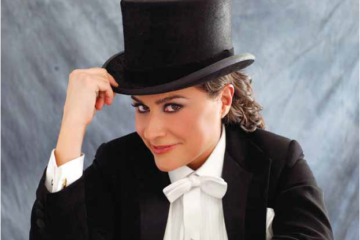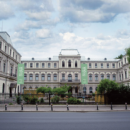
CLASSIC & CONTEMPORARY
Goldart, an auction house, art gallery and event planner, is an important member of the Romanian cultural movement. One could call it a family business, and a successful one at that. The group consisting of Luminita, Alexandru and Mihnea Ghidus have recently been joined by Sandra, the youngest of the four, a first year student at the National University of Arts, the Art History and Theory department.
Soon after the ’89 revolution, both the Romanian cultural scene and the artistic movement had been seriously redefined. If, at first, the grounds were still rather uncertain, things changed in time – following the already tried and tested models, the market began to be populated by more and more specialty shops, art galleries and auction houses. Romanian art was soon circulating freely, appearing in big museums and galleries all over. Collectors from all around the world were meeting with first class artists and their works, authentic talents who would place their mark on the evolution of world culture. Locals valued these ambassadors and creators of beauty, whether they were designers, architects, musicians, writers, painters or sculptors. They have brought Romania in the centre of public attention and, most importantly, public admiration.
Behind any artist’s success story there lies a major promoting effort. An art gallery’s role is not solely to present and help familiarize the author’s oeuvre, but also to build the market share, to sell and to promote, to constantly maintain them in the centre of the public’s and critics’ attention. Contemporary art implies innovation, vision and language, a certain creational dynamism and establishing a dialogue with the beholder. They also need a guarantee of authenticity, one that can be issued by a professional appraiser. As a collector, one desires a certain valuable piece of art. One can find it in an antique shop, but who can guarantee it as a good investment, and the reliability of the acquisition? One owns or receives a vintage item bearing the marks of time, and would like to know, beside its sentimental value, how much it is worth. Where might one get a valuation, particularly if they were inclined to sell it? One intends to offer a particularly fancy present.
How would one go about it? The answer to all the above questions would be an auction house. It distributes items of a certain level and includes professional collaborators with a long activity in the field. Goldart ensured its continuity in the Romanian art market precisely because of its competence and dependability. Goldart’s story began in 1997, its debut coinciding with the inauguration of the Hilton Athenée Palace Hotel in Bucharest. It aimed to represent the relationship between Romanian design and contemporary art on the one side, and the market and public on the other. In 2008, the gallery’s offer widened, including interwar art into its field of interest, as the Goldart Auction House came into being. Art exhibitions, cultural and charity events, catalogues issue, collaborations with cultural institutions and artists – these are just some examples of the means that have been employed, making Romanian creations available both within the borders and abroad.
Following rigorous valuation and thorough documentation, Goldart guarantees the presence of real interwar and contemporary values in public auctions, within a variety of fields, from painting, drawing, sculpture, photography and decorative arts to illustrations and antique books. They have also been recognized for having stayed adamant in their efforts to promote contemporary creations, ever since Alexandru Ghiduș first came up with the idea in 2002, a matter on which he comments in: “This issue – ‘Contemporary Art’ – is one that necessitates a special interest, as Romania is one of a few countries that, unfortunately, is yet to grant it the attention it deserves.
The Romanian market is mainly focused on safe investments, “older art” and well-known artists, thus, in our opinion, perpetuating a serious educational fault (both culture- and investment-wise), coupled with parting from the direction of the international artistic phenomenon, one that, though somewhat distant, does every so often include Romanian artists as well. Backed by artists and designers active in art and design creation and promotion, Goldart Auction House’s management strives to promote contemporary creations, even though the sales rhythm and volume, from an economic standpoint, are not exactly encouraging, but a continued presence of contemporary art in auctions and its future constitutes the focus point of one of our long term objectives.”
And while we’re on the subject of contemporary art, let us point out the fact that, as a phenomenon, it permeates the adjacent field of interior decoration. Pieces of furniture and light fixtures have become cultural items, with their own well deserved place in museums world-wide. In order to integrate old pieces in a modern ensemble or in order to include latest generation elements in a classical approach, one needs an expert’s advice. His role, hardly negligible, is to avoid kitschy results or the useless amassing of objects that share no thematic continuity.
Design constitutes, within the Goldart gallery and auction house, the object of Mihnea Ghiduș’s interest, a graduate of the Stuttgart State Academy of Art and Design, member of the UAPR (The Romanian Fine Arts Union) and the SDPR (The Romanian Society of Professional Designers), coordinator of the “Dizainăr” project, a Romanian product, graphic and interior design shop. As with other important cities of the world, Bucharest now has its places where one could, while enjoying a glass of champagne, sample the exciting atmosphere of an auction house, where “going once, going twice, sold!” is the sound of a solid investment in art.









